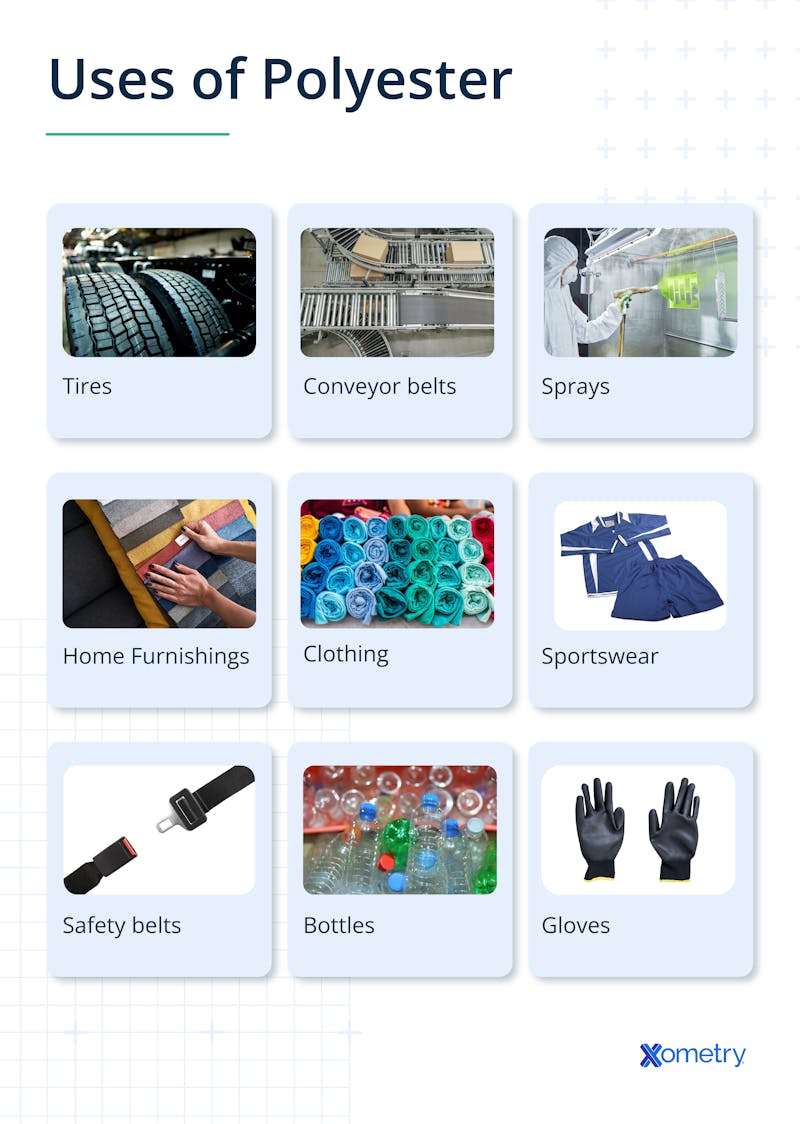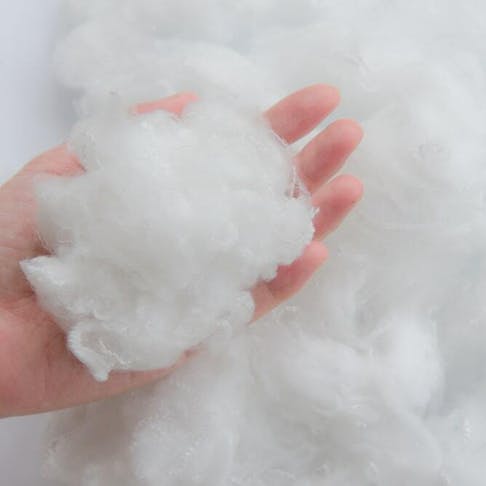Polyester is one of the most widely used polymers. It is extensively utilized in fabric form, specifically in clothing and industrial textiles. This article will describe 9 common uses of polyester – as shown in the image below – and give reasons why polyester is particularly useful in these different applications.

1. Used in the Production of Clothing
The most common application of polyester is in fabrics. Polyester fabric has properties that make it ideal for use as clothing due to its durability, low cost, and resistance to staining. Even though polyester is not inherently breathable, modern advancements in fabric engineering, such as moisture-wicking technologies and specialized weaving methods, have made it a popular choice for breathable thermal and athletic clothing. Moreover, polyester is typically blended with other natural fabrics to increase comfort and reduce the amount of creasing that is common with polyester. Polyester fabric is one of the most widely used textiles on the planet. This is partly due to its low cost and high durability. Fabrics made from polyester will melt when exposed to an open flame and can cause serious injury. Polyester fabrics are not typically recycled due to the addition of other materials like cotton which are difficult to separate from polyester.
2. Used for Home Furnishings
Polyester textiles are used in home furnishing applications. Its stain resistance is what makes polyester such an excellent material for furniture coverings. Polyester can also be tinted with a wide array of colors. The material is also lightweight. This property is especially important for items like curtains which can be difficult to install if made from heavy fabrics.
3. Manufacturing of Tires
Tire manufacturing is another common use for polyester fiber. Tires are produced from a range of different materials; polyester is placed in strategic positions throughout the tire as a reinforcing material. Polyester reinforcing fabrics improve strength, durability, handling, and many other performance-critical criteria. When compared to other common reinforcing fabrics like nylon, polyester has improved dimensional stability, lower shrinkage, and better high-speed performance.
4. Applied to Conveyor Belts
Conveyor belts are often manufactured with reinforcing polyester carcasses throughout the belt. Increasing the number of textile carcasses will improve the overall tensile strength and stiffness of the belt. These textiles are often made from polyester and significantly improve the performance of the belt. Mechanically splicing belts using fasteners is easier in belts with polyester reinforcement textiles. This reinforcement helps retain the fasteners so that they do not tear out when the belt is under load. Adding a textile cover to the top or bottom of the belt can also reduce overall sliding friction.
5. Production of Safety Belts
One of the most important uses of polyester is in car seat belts made from polyester textiles. Polyester has excellent tensile strength, especially when woven into a dense fabric, making it ideal for seat belts. In addition to this, polyester does not stretch easily and has excellent durability which is critical in ensuring the safety of passengers. Any damage occurring to the safety belt would present a potential failure point when the belt is used.
6. Used for Padding Upholstery, Cushioning, and Insulating Gloves and Mitts
Polyester is often used as a batting material for cushions and upholstery. The material tends to retain its volume and shape even after being compressed multiple times. Polyester batting is also resistant to mold and mildew while also being an excellent insulator. These insulation properties make polyester ideal for applications like oven gloves and mitts. Polyester tends to melt if exposed to direct flames. Therefore, it is often placed between cotton layers to protect the polyester even if the mitts come into contact with high temperatures.
7. Used in the Making of Bottles
The disposable plastic bottle is one of the most common uses of polyester. Polyester is resistant to microorganisms and does not degrade biologically. In general, polyester is a very durable material, making it ideal for plastic bottles. Plastic bottles made with polyester are manufactured using the blow-molding technique. At the end of their lifetime, polyester bottles are often recycled into polyester fabrics. However, this is primarily influenced by the limited availability of recycling infrastructure and consumer participation, rather than any limitations in the material properties of PET itself.
8. Used in Manufacturing Sports Gear, Sportswear, Upholstery, Covers, and Tablecloths
Polyester is a very durable material, especially when exposed to an outdoor environment, and does not stain easily. These properties make it ideal for sportswear and equipment. Polyester does not absorb moisture, so it is an ideal material to use when exercising. These same properties make polyester ideal for upholstery and tablecloths.
9. Used in Manufacturing Sprays
Polyester is used in a number of spray-coating applications. Sprays made with polyester have lower performance in terms of durability and chemical resistance when compared to epoxy paint. However, polyester coatings provide improved performance over polyurethane coatings. Polyester paint is made from a three-component system that consists of a resin, a catalyst, and an accelerant. Polyester paints are typically used for varnishing furniture and have excellent scratch resistance and general toughness.
What Are the Different Types of Polyester That Can Be Used?
There are four common types of polyester, with PET (Polyethylene Terephthalate) being by far the most commonly used. The different types of polyesters are listed below:
- PET (Polyethylene Terephthalate): This is the most commonly used grade of polyester and is known by the following trade names: Mylar, Rynite, and Impet
- PBT (Polybutylene Terephthalate): When compared to PET, PBT has a lower melting temperature
- PEN (Polyethylene Naphthalate): PEN is used in packaging applications as oxygen does not easily permeate through the packaging
- PTT (Polytrimethylene Terephthalate): Has good stain resistance and durability – as such it is typically used in the textile industry
Common FAQs About Polyester
Which Type of Polyester Has a Wide Range of Applications?
Polyester is the most used as a fabric or textile. This application includes fishing nets, carpets, ropes, clothing, sportswear, and air filters. Polyester accounts for over half the total fiber use globally.
Where Is Polyester Most Commonly Used?
Due to the prevalence of polyester fabric, polyester is used almost everywhere that fabrics are utilized. This means the consumer, via industries such as clothing, automobiles, and medicine, makes heavy use of polyesters.
Who Is the Most Common User of Polyester?
The largest consumer of polyester fibers is China. This is no surprise as China also leads in terms of global polyester production.
How Much Does Polyester Cost?
In 2023, the price of polyester staple fibers in China rose by 2% to approximately $1,006 per ton. Prices peaked at around $1,094 per ton in mid-September. The increase was primarily driven by higher costs of intermediate products like PTA (terephthalic acid) and MEG (monoethylene glycol), which are essential for polyester production.
Is Polyester a Long-Lasting Material?
Polyester is a very durable and long-lasting material. This is why it is used in applications that require long-lasting performance like seat belts, for example.
Summary
This article summarized nine uses of polyester across different industries and discussed some of the most common types of this material.
Xometry offers injection molding services for all of your prototyping and production needs. Visit our website to learn more and to request a free, no-obligation quote using our Instant Quote Engine.
Disclaimer
The content appearing on this webpage is for informational purposes only. Xometry makes no representation or warranty of any kind, be it expressed or implied, as to the accuracy, completeness, or validity of the information. Any performance parameters, geometric tolerances, specific design features, quality and types of materials, or processes should not be inferred to represent what will be delivered by third-party suppliers or manufacturers through Xometry’s network. Buyers seeking quotes for parts are responsible for defining the specific requirements for those parts. Please refer to our terms and conditions for more information.


